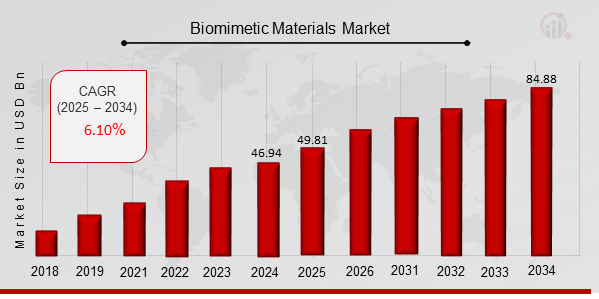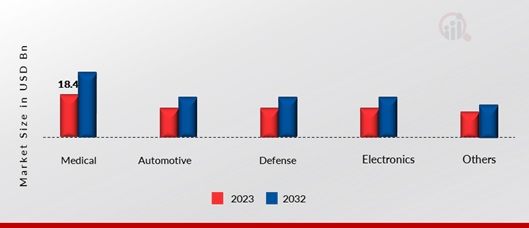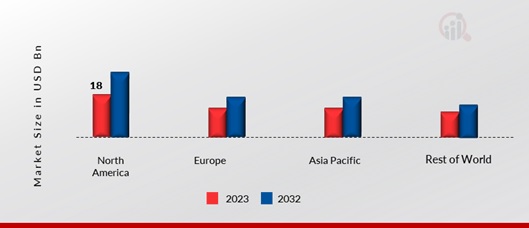As per MRFR analysis, the Biomimetic Materials Market Size was estimated at 46.94 (USD Billion) in 2024. The Biomimetic Materials Market Industry is expected to grow from 49.81 (USD Billion) in 2025 to 84.88 (USD Billion) till 2034, at a CAGR (growth rate) is expected to be around 6.10% during the forecast period (2025 - 2034). Advances in nanotechnology and a rise in research and development are the key market drivers boosting the expansion of the market.

Source: Primary Research, Secondary Research, MRFR Database and Analyst Review
Biomimetic Materials Market Trends
- Growing technological innovation in nanotechnology is driving the market growth.
Market CAGR for Biomimetic Materials is being driven by the rising technological innovation in nanotechnology. Materials with inherent and extrinsic properties that enable them to change in response to external environmental conditions are known as biomimetic materials. These are naturally clever and energetic creatures with a chemical makeup that enables situational adaptation. These materials have found a variety of applications in industries like nanotechnology, robotics, medical devices, defense, automotive, and others. These industries also exhibit growing and attractive potential for the development of biomimetic materials. These materials are called biogenesis, biomimicry, bionics, and bioinspiration.
Additionally, Throughout the predicted period, medical biomimetics will rise thanks to the development of medicine delivery methods made possible by advancements in nanotechnology. Because of their biocompatibility, physical characteristics, and chemical makeup, nanomaterials are attractive for use in biomedical applications and have great potential in biomimicry medicine. Improved biocompatibility, stability, targeting, and specificity of biomimetic nanomaterials have been made possible by the development of biomimetic functionalized nanotechnology, which has made it possible to functionalize and modify nanoparticles using elements of cell membranes. These biomimetic functionalized nanomaterials can establish selectivity for tissue disease or biomarkers, suggesting that they can be used for disease detection. This is why there is a lot of interest in using biomimetic nanoparticles to diagnose diseases without the need for intrusive procedures.
It is expected that growing R&D activities and the expanding application potential of medical biomimetics will drive market expansion in the diagnostic imaging space, which includes ultrasound, electrocardiographs, and computed tomography scans. For example, a biomimetic, flexible, steerable probe is now being developed at Imperial College London. This research aims to precisely place localized drug delivery, micro neurosurgery, clinical analysis, and diagnosis (sampling, biopsy) with minimally invasive instrumentation (electrodes, catheters for deep brain stimulation) and to access deep brain regions with the least amount of damage.
For instance, the number of hip replacement surgeries performed on those 45 and older increased from 138,700 to 310,800 over the first ten years of this century, with a spike in the rate of these procedures from 142 per 100,000 to 257 per 100,000, according to the Centers for Disease Control and Prevention (CDC). Thus, it has resulted in driving up the Biomimetic Materials market revenue.
Biomimetic Materials Market Segment Insights
Biomimetic Materials Material Insights
The Biomimetic Materials Market segmentation, based on Material, includes Biomimetic Polymers, Biomimetic Ceramics & Glass, Biomimetic Metals & Alloys, and Others. In 2023, the Biomimetic Polymers segment dominated the market because of the rise in demand for biomimetic polymers in industries including electronics, biomedicine, and pharmaceuticals. Moreover, biomimetic polymers have benefits like improved underwater adhesion, biocompatibility, modulus that may be adjusted, and antibacterial and antifouling properties. Raises the need for biomimetic polymers throughout the analysis.
Biomimetic Materials Application Insights
The Biomimetic Materials Market segmentation, based on Application, includes Medical, Automotive, Defense, Electronics, and Others. In 2023, the Medical category generated the most income due to the increase in demand for biomimetic materials in medical applications, such as contact lenses, joint replacements, skin repair devices, sensors in tissue responses, bone cement in bone-bonding systems, systems enabling localized drug delivery, and dental implants for tooth fixation.
Figure 1: Biomimetic Materials Market, by Application, 2023 & 2032 (USD Billion)

Source: Primary Research, Secondary Research, MRFR Database and Analyst Review
Biomimetic Materials Regional Insights
By region, the study provides market insights into North America, Europe, Asia-Pacific, and the Rest of the World. The North American Biomimetic Materials market area will dominate this market. The significant portion is mostly attributable to the region's high level of R&D activity, high rate of innovative technology adoption, high level of disposable income, and presence of significant market competitors.
Further, the major countries studied in the market report are China, Japan, India, Australia, South Korea, Brazil, Germany, France, the UK, Italy, and Spain.
Figure 2: Biomimetic Materials Market Share By Region 2023 (USD Billion)

Source: Primary Research, Secondary Research, MRFR Database and Analyst Review
Europe Biomimetic Materials market has the second-largest portion of the market. This is explained by the region's large consumer base and the presence of important players. Further, the German Biomimetic Materials market held the largest market share, and the UK Biomimetic Materials market was the European market with the quickest rate of growth.
The Asia-Pacific Biomimetic Materials Market is anticipated to expand between 2025 and 2034 at the quickest CAGR. This is because of the region's large patient population, rising awareness of and adoption of new technologies, and rising investments in medical and healthcare facilities. Moreover, China’s Biomimetic Materials market held the largest market share, and the Indian Biomimetic Materials market was the Asia-Pacific region's fastest-growing market.
Biomimetic Materials Key Market Players & Competitive Insights
Leading market players are putting a lot of money into R&D to expand their product lines, which will help the market for weight reduction products grow. Additionally, market players are engaging in a range of calculated initiatives to increase their worldwide presence, with important market developments involving the introduction of new products, contracts, M&A transactions, increased investment, and cooperation with other enterprises. To grow and endure an increasingly cutthroat and dynamic market, the Biomimetic Materials industry must provide reasonably priced goods.
Manufacturing locally is one of the primary business techniques used by manufacturers to cut operational costs in the global Biomimetic Materials industry to help customers and expand the market segment. In recent years, the Biomimetic Materials industry has provided some of the biggest benefits to medicine. Major players in the Biomimetic Materials market, including Piezo Kinetics, CTS Corporation, Lord Corporation, TDK Corporation, Applied Biomimetic, Wright Medical Group, CeramTec., Noliac AS, Kyocera Corporation, APC International, and others, are engaging in research and development activities in an effort to boost market demand.
TDK Corporation is a multinational electronics company based in Japan that produces electronic parts and media for data storage and recording. Its motto is "Use creativity to advance industry and culture." Tokyo Denki Kagaku Kōgyō K.K., or Tokyo Electric Chemical Industry Co., Ltd., was the company's original Japanese name, which is abbreviated as "TDK." The company is part of the Nikkei 225 and TOPIX indices, and it is listed on the Tokyo Stock Exchange. In 2023, The US-based company Qeexo, Co., which developed embedded AI and tinyML technologies, was purchased by TDK Corporation.
The CeramTec Group is a developer and producer of technical ceramics (sometimes called advanced technical ceramics) products and components. Among other channels, the company's own sales companies are used to marketing the products. The chemical and semiconductor industries, medical technology, automotive engineering, electronics, mechanical, equipment, and environmental and energy technology are the main industries that use them. The company's main office is in Plochingen, Germany's Baden-Württemberg region. In September 2023, At CeramTec's Marktredwitz location, a formal groundbreaking ceremony was held for a new structure intended to increase manufacturing capacity in the medical technology industry.
Key Companies in the Biomimetic Materials market include
- Piezo Kinetics
- CTS Corporation
- Lord Corporation
- TDK Corporation
- Applied Biomimetic
- Wright Medical Group
- Noliac AS
- Kyocera Corporation
- APC International
Biomimetic Materials Industry Developments
May 2022: Premier, Inc. has awarded a group buy agreement to Veryan Medical Inc. for peripheral and biliary stents. The new deal will take effect on May 1, 2022, and Premier members will be able to take advantage of special terms and prices that Premier has arranged in advance for the BioMimics 3D Vascular Stent System.
December 2022: Stryker introduced Citrefix, a suture anchor system for foot and ankle surgical procedures. Citregen, a highly regarded bioresorbable material designed to mimic the makeup and morphology of genuine bone, is used in the new technology.
January 2023: Nobel Biocare has expanded its line of regeneration products under the Creos brand with the introduction of Creos Syntogain. Since 2016, Creos Syntogain, also known as MimetikOss, has been a popular and widely accessible biomimetic bone graft substitute on the Spanish market.
Biomimetic Materials Market Segmentation
Biomimetic Materials Material Outlook
- Biomimetic Polymers
- Biomimetic Ceramics & Glass
- Biomimetic Metals & Alloys
- Others
Biomimetic Materials Application Outlook
- Medical
- Automotive
- Defense
- Electronics
- Others
Biomimetic Materials Regional Outlook
- North America
- Europe
- Germany
- France
- UK
- Italy
- Spain
- Rest of Europe
- Asia-Pacific
- China
- Japan
- India
- South Korea
- Australia
- Rest of Asia-Pacific
- Rest of the World
- Middle East
- Africa
- Latin America
| Report Attribute/Metric |
Details |
|
Market Size 2024
|
46.94 (USD Billion)
|
|
Market Size 2025
|
49.81 (USD Billion)
|
|
Market Size 2034
|
84.88 (USD Billion)
|
|
Compound Annual Growth Rate (CAGR)
|
6.10 % (2025 - 2034)
|
|
Report Coverage
|
Revenue Forecast, Competitive Landscape, Growth Factors, and Trends
|
|
Base Year
|
2024
|
|
Market Forecast Period
|
2025 - 2034
|
|
Historical Data
|
2020 - 2024
|
| Report Coverage |
Revenue Forecast, Market Competitive Landscape, Growth Factors, and Trends |
| Segments Covered |
Material, Application, and Region |
| Geographies Covered |
North America, Europe, Asia Pacific, and the Rest of the World |
| Countries Covered |
China, Japan, India, Australia, South Korea, Germany, France, UK, Italy, and Spain |
| Key Companies Profiled |
Piezo Kinetics, CTS Corporation, Lord Corporation, TDK Corporation, Applied Biomimetic, Wright Medical Group, CeramTec., Noliac AS, Kyocera Corporation, APC International |
| Key Market Opportunities |
· Advances in nanotechnology development |
| Key Market Dynamics |
· Increasing R&D expenditures and the growing range of applications for medical biomimetics |
Frequently Asked Questions (FAQ) :
In 2023, the market for Biomimetic Materials was estimated to be worth USD 41.7 billion worldwide.
From 2025 to 2034, the global market is expected to expand at a compound annual growth rate of 6.10%.
North America held the most market share worldwide.
The key players in the market are Piezo Kinetics, CTS Corporation, Lord Corporation, TDK Corporation, Applied Biomimetic, Wright Medical Group, CeramTec., Noliac AS, Kyocera Corporation, APC International, and others.
In 2023, the market was dominated by the Biomimetic Polymers sector.
The medical company holds the biggest market share worldwide.

















